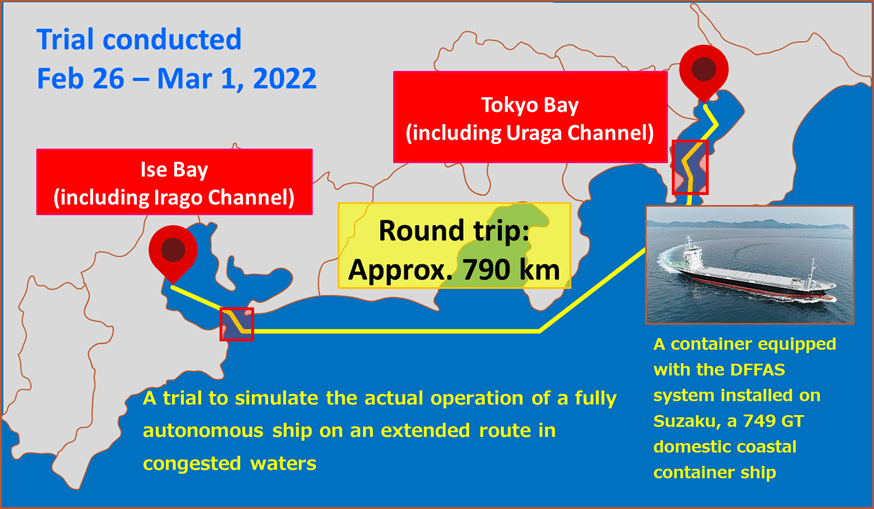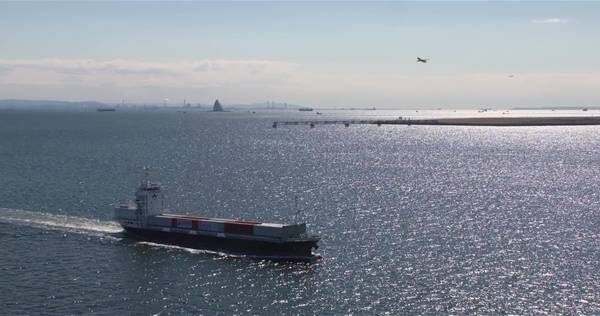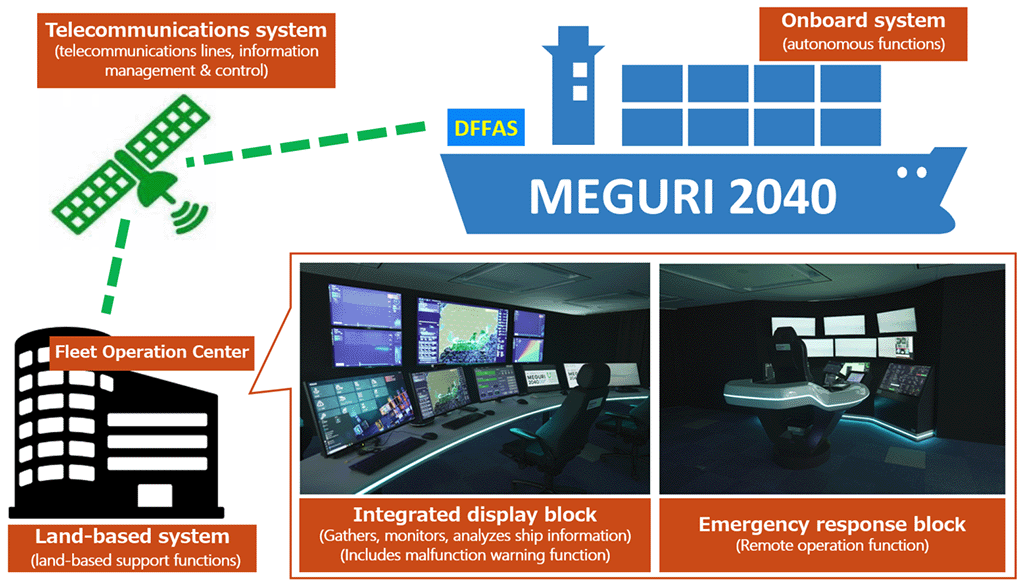News & Press Release
Trial simulating the Actual Operation of Fully Autonomous Ship
at a distance of approximately 790 kilometers between Tokyo Bay and Ise Bay
Shipping >From February 26 to March 1, the DFFAS (Designing the Future of Full Autonomous Ship) consortium* conducted a trial simulating the actual operation of a fully autonomous ship at a distance of approximately 790 kilometers between Tokyo Bay and Ise Bay.
The DFFAS project comprises 30 Japanese companies. The consortium is participating in the Joint Technological Development Programme for the Demonstration of Fully Autonomous Ships under the fully autonomous ship project "MEGURI 2040" administrated by the Nippon Foundation.
In the trial, the container ship Suzaku was equipped with an autonomous navigation function and connected by satellite and a ground communication line to a fleet operation center that had functions such as remote maneuvering and engine-abnormality prediction to support the operation of a fully autonomous ship from shore.
The trial was then conducted in a manner that simulated the actual operation of future fully autonomous ships, successfully completing a series of voyages that amounted to about a 790-kilometer round-trip between Tokyo Bay and Ise Bay, including offshore maneuvering, bay navigation, coastal navigation, and berthing maneuvering, using a comprehensive fully autonomous navigation system (DFFAS system).**
Weathernews has developed a navigation plan formulation system that automatically selects the optimum route using an AI model that has learned using actual navigation data and vessel performance data, developed an ultra-high-resolution forecast model and probabilistic forecasting technology, and provided navigation support from the shore-side support center. Going forward, these will be applied to Weathernews' autonomous ship support services as core technologies.
Designing the Future of Full Autonomous Ship Consortium
The DFFAS consortium is made up of about 60 domestic and overseas cooperating companies and organizations, including 30 companies from diverse fields. The consortium has developed its DFFAS system using an open innovation framework. In the trial, Suzaku (95 meters, 749 gross tons) navigated a 790-kilometer round-trip route departing from and returning to Tokyo Bay by way of Ise Bay using a DFFAS system, including remote operation from the fleet operation center in Chiba prefecture. This successful trial in the highly congested area of Tokyo Bay, which has roughly 500 ships passing through each day, verifies a high level of technological development that represents a significant step toward practical implementation. In addition to addressing the issues of aging crew and crew shortages facing the domestic coastal shipping industry and the social issue of accident reduction, remote operation from shore can be expected to introduce new work styles and increase labor capacity for crews.
Trial and development highlights
With an eye toward full-scale implementation, the DFFAS consortium developed a DFFAS system with repeated risk assessments carried out from the design stage. The system has three primary components: (1) a ship-side navigation system that controls autonomous functions from the ship; (2) a shore-side system that monitors and supports the ship from shore, including remote ship-handling functions; and (3) an information and communications system that enables stable communication between the ship and shore. The fleet operation center marks a particular advance, allowing fully autonomous navigation at sea with tracking from shore of functions normally performed by crew, including the monitoring of weather and sea conditions, traffic flow, and the ship’s equipment. In emergency situations, the system can switch to remote operation from the fleet operation center, ensuring the overall system’s safety and stability.
Weathernews' Autonomous Ship Support
Weathernews mainly provided three types of support.
1. Development of a navigation plan formulation system wherein AI determines the optimum vessel route
The system uses measurement data obtained from the vessel, together with data available on the shore side, to automatically formulate a comprehensive navigation plan that takes safety and environmental impact into consideration. Using various elemental technologies, the system makes corrections to the optimum route that is determined based on past navigation data, as well as hydrographic and meteorological conditions, for improved accuracy. It is possible, for example, to make detailed corrections that take vessel-specific features into consideration by calculating the impact of hydrographic and meteorological conditions on the vessel using an AI analysis of the vessel's performance capability based on naval architecture, marine engineering, and machine learning, and using the results in combination with the latest hydrographic and meteorological information. Further, the system enables the selection of a more optimal route by making corrections based on vessel traffic flow, which covers information such as locations with heavy traffic and movements and other characteristics of vessels in the periphery.
2. Development of an ultra-high resolution forecast model and probabilistic forecasting technology
Weathernews developed an ultra-high-resolution prediction model with a 10-meter mesh for wind forecasting and a 100-meter mesh for ocean current forecasting in order to support the automatic docking and undocking of vessels. During a field test using the model, we succeeded in accurately capturing localized hydrographic and meteorological changes along the coast, where prediction is said to be more difficult compared to open seas. We also provided support for safe navigation by developing a probability forecasting technology applicable to medium- and long-term wind and wave forecasts along the routes, which involve a high degree of uncertainty.
3. Navigation support from shore-side support center
Prior to the field test, Weathernews analyzed five years' worth of past weather data for the area around the scheduled route to obtain the frequency with which specific wind speeds and wave heights were observed for use in establishing the threshold conditions for determining the operability of vessels. We also provided support for appropriate decision making by sharing quantitative and objective information on meteorological and hydrographic risks along the scheduled route with DFFAS members, through the continuous updating of short-term forecasts covering spans of a few days to one week ahead and long-term forecasts covering spans of several months.
Risk communicators (meteorologists specializing in marine meteorology) were assigned to the Fleet Operation Center (FOC) in Makuhari, Chiba City, during the field test to provide navigation support through the provision of highly accurate weather forecasts using the latest meteorological and hydrographic data, observation data from vessels, and shore-side observation data for the periphery of the vessels.
* Companies participating in the DFFAS project include Japan Marine Science Inc. (project leader); MTI Co., Ltd.; Ikous Corporation; BEMAC Corporation; Kinkai Yusen Kaisha Ltd.; SKY Perfect JSAT Corporation; Tokio Marine & Nichido Fire Insurance Co., Ltd.; Tokyo Keiki Inc.; Nippon Telegraph and Telephone Corporation; NTT DOCOMO, Inc.; Japan Radio Co., Ltd.; Mitsubishi Research Institute Inc.; Sunflame Co., Ltd.; Sanwa Dock Co., Ltd.; Suzuyo Marine Co., Ltd.; Furuno Electric Co., Ltd.; Weathernews Inc.; EIZO Corporation; Mitsui Sumitomo Insurance Company, Limited; NTT Communications Corporation; Japan Hamworthy Co., Ltd.; Japan Marine United Corporation; Nabtesco Corporation; NX Shipping Co., Ltd.; NYK Line; pluszero Inc.; Honda Heavy Industries Co., Ltd.; Miura Co., Ltd.; Nihon Shipyard Co., Ltd.; YDK Technologies Co., Ltd.
** The comprehensive fully autonomous navigation system developed by the DFFAS consortium adopts a fully autonomous ship framework that is currently being developed under the name of "APExS-auto." APExS-auto is applying for approval in principle (AiP) from ClassNK and the French classification society Bureau Veritas.
<Press Release by Nippon Foundation>
https://www.nippon-foundation.or.jp/en/news/articles/2022/20220301-67775.html
Click here to download PDF


